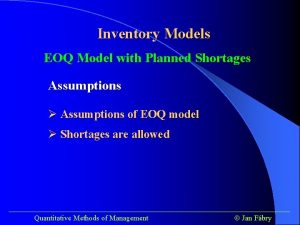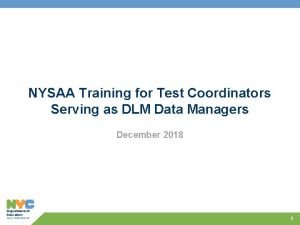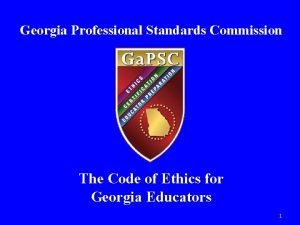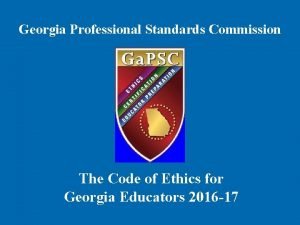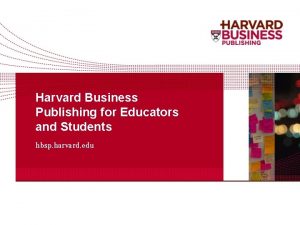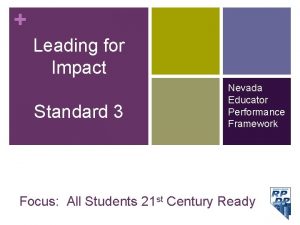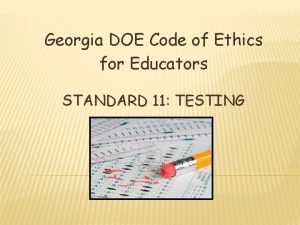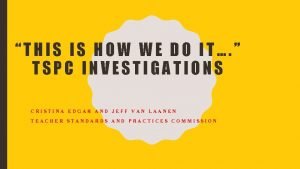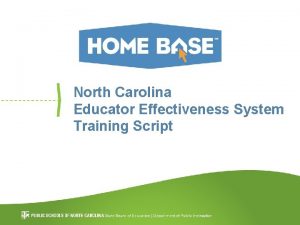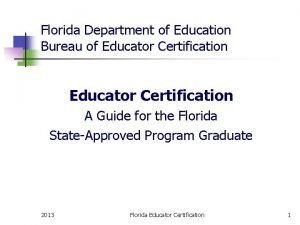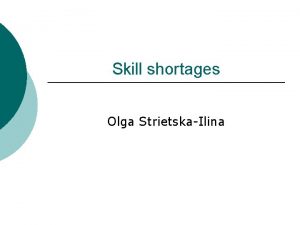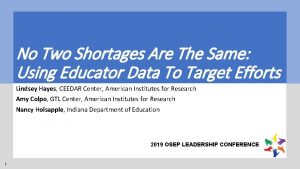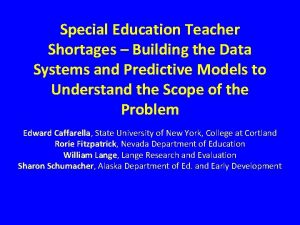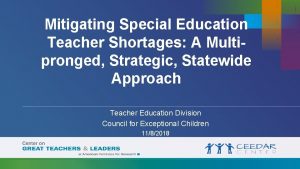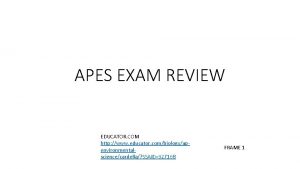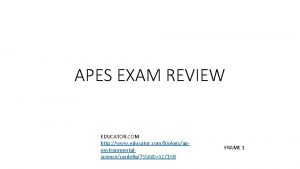Educator Shortages in Special Education Toolkit Mary T


























- Slides: 26

Educator Shortages in Special Education Toolkit Mary T. Brownell, Director CEEDAR Amy Colpo, TA Specialist Copyright © 20 XX American Institutes for Research and Collaboration for Effective Educator Development, Accountability, and Reform. All rights reserved.

WHY SHOULD WE BE CONCERNED? • 48 states and the District of Columbia report shortages of special education teachers. • 42 states report a shortage of early intervention providers. • Special education teachers leave the profession at nearly twice the rate of general education teachers. • Enrollment in teacher preparation programs is down 35% over the last 5 years. Source: Council for Exceptional Children, 2018. 2

EQUITY ISSUES • 90% of high-poverty school districts report difficulty attracting qualified special education teachers. • There are severe and persistent shortages of special educators from diverse backgrounds. • Students with serious emotional & behavioral disorders are disproportionately affected. Source: Council for Exceptional Children, 2018; Fall & Billingsley, 2011.

THE CHALLENGE • Districts are left with few choices and often rely on “fast-track” and emergency-certified teachers with little preparation and no classroom experience to fill positions. • Short-term solutions exacerbate quantity and quality issues and create a revolving door. • Long-term solutions like policy change take time! Source: Boe, Cook, & Sunderland, 2006; Feng & Sass, 2013; Ingersoll, Merrill, & May, 2014.

THE SOLUTION § A comprehensive educator talent management framework that: üEncompasses the entire educator career continuum üConsiders unique local contexts üClarifies partner roles 5

PREPARING AND RETAINING EFFECTIVE SPECIAL EDUCATION TEACHERS • Brief outlines the research supporting short-term and longterm strategies for reducing shortages. • https: //www. dropbox. com/s/zffg 1 ozk 1 njzso 5/Screenshot%20201 9 -10 -09%2023. 09. 08. png? dl=0

SPECIAL EDUCATION SHORTAGES TOOLKIT 7

SPECIAL EDUCATION TEACHER SHORTAGES TOOLKIT gtlcenter. org

GUIDING PRINCIPLES 1) Shortages are a local issue. 2) Shortages are an equity issue. 3) Shortages can impact any stage of the career continuum. 4) Shortages require collaboration across partners at all stages of the career continuum. Short-Term Strategies Long-Term Strategies Hire and support candidates to fill immediate vacancies Attract, prepare, and retain an effective teacher workforce Comprehensive Solutions for Special Education Teacher Shortages

Purpose • To help teams identify and implement a combination of short- and long-term educator talent management strategies. Audience • • State education agency (SEA) personnel Regional education agency personnel Local education agency (LEA) personnel Educator preparation program (EPP) personnel

STAGES WITHIN THE THREE-PHASE PROCESS

Starting Point: Data, Root Cause, & Context Where do the gaps start? Center on Great Teachers and Leaders at American Institutes for Research What are the root causes for gaps? Context is crucial!

Data Tool § PURPOSE: Tool for identifying and visualizing special education teacher shortages across the career continuum. § AUDIENCE: State teams consisting of state, regional, local, and educator preparation program stakeholders Question: What kinds of data sources are you currently using to examine special education teacher shortages?

Data Tool Lenses § Development of Gaps: Compares the attrition of special education teachers with the attrition of the overall teacher population throughout the career continuum. § Teacher Hiring Funnel: Focuses on the educator career continuum specifically for special education teachers, identifying the most significant moments of attrition. § Accountability Score Results: Identifies how special education teacher attrition varies across districts and schools based on outcomes for SWDs as measured by Every Student Succeeds Act (ESSA) accountability scores. 14

Gaps in special educator retention compared with overall teacher population 15

Teaching Hiring Funnel 16

Retention and ESSA Accountability 17

LONG-TERM STRATEGIES

Purpose • To identify evidence-based short- and long-term strategies per local context. Audience • • State education agency (SEA) personnel Regional education agency personnel Local education agency (LEA) personnel Educator preparation program (EPP) personnel


ROLE AND FUNDING GUIDE

LEARNING POLICY INSTITUTE TEACHER SHORTAGE SOLUTIONS TOOLKIT 22

Drives what we are doing to support states in reducing shortages

QUESTIONS?

REFERENCES • Boe, E. E. , Cook, L. H. , & Sunderland, R. J. (2006). Attrition of beginning teachers: Does teacher preparation matter. Center for Research and Evaluation in Social Policy. University of Pennsylvania, Philadelphia. • Council for Exceptional Children. (2018). Issue brief: Special education teacher and early intervention provider shortages. Arlington, VA. Retrieved from https: //www. cec. sped. org/~/media/Files/Policy/2018%20 Updated%20 Issue%20 Briefs/IB%20 Shortages%20062718. pdf. • Fall, A. M. , & Billingsley, B. S. (2011). Disparities in work conditions among early career special educators in high-and low-poverty districts. Remedial and Special Education, 32(1), 64 -78. • Feng, L. , & Sass, T. R. (2013). What makes special-education teachers special? Teacher training and achievement of students with disabilities. Economics of Education Review, 36, 122 -134. • Ingersoll, R. M. , Merrill, L. , & May, H. (2014). What are the effects of teacher education and preparation on beginning teacher retention? Philadelphia, PA: Consortium for Policy Research in Education.

DISCLAIMER This content was produced under U. S. Department of Education, Office of Special Education Programs, Award No. H 325 A 170003. David Guardino serves as the project officer. The views expressed herein do not necessarily represent the positions or polices of the U. S. Department of Education. No official endorsement by the U. S. Department of Education of any product, commodity, service, or enterprise mentioned in this website is intended or should be inferred.
 Eoq model with planned shortages
Eoq model with planned shortages Supply chain shortages are
Supply chain shortages are Definition of scarcity in economics
Definition of scarcity in economics Mary wollstonecraft mary a fiction
Mary wollstonecraft mary a fiction Education scotland play pedagogy toolkit
Education scotland play pedagogy toolkit Nysaa training
Nysaa training Format of micro teaching lesson plan
Format of micro teaching lesson plan Teachers violating the code of ethics in georgia
Teachers violating the code of ethics in georgia Georgia educator code of ethics
Georgia educator code of ethics Msde educator portal
Msde educator portal Nurse educator resume
Nurse educator resume Microsoft teacher academy
Microsoft teacher academy Health education define
Health education define Harvard business review for educators
Harvard business review for educators Allied educator moe
Allied educator moe Alabama educator code of ethics
Alabama educator code of ethics Slo and ppg examples
Slo and ppg examples Turing tumble simulator
Turing tumble simulator Nevada educator performance framework
Nevada educator performance framework Georgia code of ethics for educators
Georgia code of ethics for educators Tspc educator sanction list
Tspc educator sanction list Vumc educator portfolio
Vumc educator portfolio Office of educator services
Office of educator services Nc educator effectiveness system
Nc educator effectiveness system Bureau of educator certification florida
Bureau of educator certification florida Ct sde certification lookup
Ct sde certification lookup Microsoft educator network
Microsoft educator network
